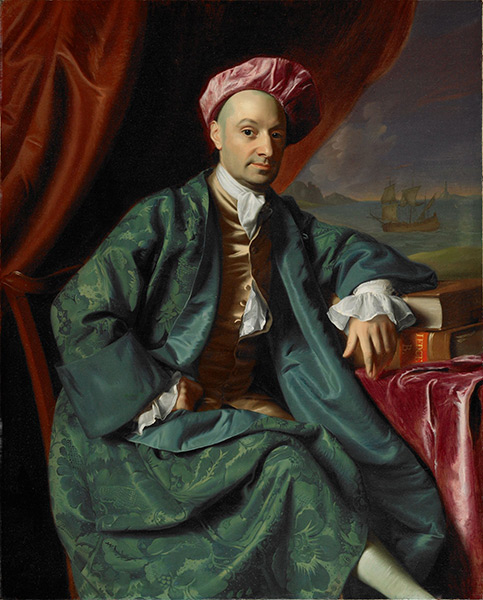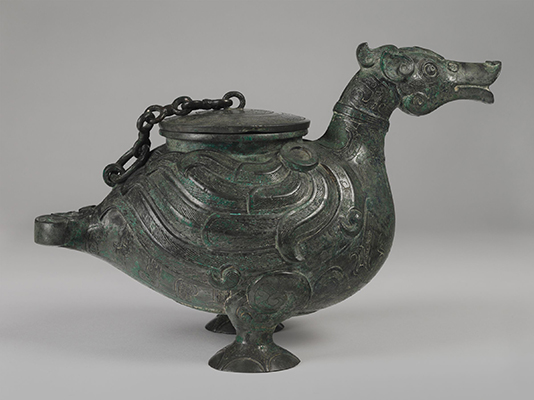As a new year unfolds, the Harvard Art Museums are grateful for a number of recent gifts and grants in support of future programming and educational opportunities. The impact of these significant contributions from major foundations, institutions, and an individual donor will be felt both immediately and over the coming years.
Specifically, the gifts and grants are:
$1 million from Harvard Business School alumnus Ken Hakuta (M.B.A. ’77) to establish the Hakuta Family Endowment Fund, enabling the creation of the Nam June Paik Fellowship at the Harvard Art Museums; $506,000 from the Andrew W. Mellon Foundation to establish a new Summer Institute for Technical Studies in Art (SITSA), which will give art history graduate students experience with object-focused technical inquiry, methodologies, and instruction; $325,000 from the National Endowment for the Humanities, in support of the Fall 2018 special exhibition Animal-Shaped Vessels from the Ancient World: Feasting with Gods, Heroes, and Kings; $250,000 from the Terra Foundation for American Art, in support of the special exhibition The Philosophy Chamber: Art and Science in Harvard’s Teaching Cabinet, 1766–1820 (May 19–December 31, 2017); and $100,000 from the Henry Luce Foundation, also in support of the Philosophy Chamber exhibition.“We take it as a great vote of confidence when significant funding is allocated to our projects,” said Martha Tedeschi, the Elizabeth and John Moors Cabot Director of the Harvard Art Museums. “The fact that such notable institutions and individuals have recognized our work lets us know that we are on the right track and that beyond our projects’ having a scholarly impact, we’ve made a case that they are important to the public as well.”
Support for Training Initiatives
Two of the gifts—the donation to establish the Nam June Paik Fellowship and the Mellon Foundation grant to establish SITSA—directly support one of the museums’ key missions: to train the next generation of art historians and museum professionals.
The Paik Fellowship, established by Hakuta, who is Paik’s nephew, will be a two-year experience for an advanced graduate student to research the 20th-century artist and pioneer in video art. Hakuta’s gift also includes approximately 10 works by Paik, making the museums an important repository of his art. Paik fellows will be able to study his works alongside other artists of Paik’s generation who are strongly represented in the museums’ collections, such as Joseph Beuys and members of the Fluxus group. The fellowship provides an exciting opportunity on multiple levels: emerging professionals will gain curatorial experience and expertise and contribute to the existing scholarship on Paik, while the museums will benefit from a deeper understanding of the artist and works in the collections.
With the backing of the Mellon Foundation grant, SITSA will build on the accomplishments of the Summer Institute in Technical Art History (SITAH), developed by and conducted at New York University over the past five years. Designed for advanced graduate students from art history programs across North America who are interested in broadening their experience with object-based study, SITSA will emphasize holistic interdisciplinary training through close looking at art, demonstrations and hands-on experimentation with artistic materials and techniques in the museums’ Materials Lab, lectures and discussions, and visits to artists’ workshops. The first cohort of approximately 15 participants will convene at the Harvard Art Musuems in June.
Francesca Bewer, research curator for conservation and technical studies programs, is leading SITSA and has selected the theme of translation for the program’s first year. Whether translating an image across media or translating an understanding of art from one viewpoint to another, it is an essential skill for art historians. Direct experiences with art making will give students the chance to strengthen their translation abilities, Bewer said.
“Many art history students still haven’t had the opportunity to learn about art making firsthand,” Bewer said. “It’s a way of learning about decision-making, and it increases appreciation for art, craft, and skill.”
Curatorial Excellence
Further bolstering the museums’ role as a laboratory for the arts, the grants from the National Endowment for the Humanities, Henry Luce Foundation, and Terra Foundation will be crucial in developing two upcoming special exhibitions. Each grant “allows us to think ambitiously and to make original contributions to the existing scholarship,” Tedeschi said.
The NEH grant helped fund important travel and research by Susanne Ebbinghaus, the head of the Division of Asian and Mediterranean Art and the George M.A. Hanfmann Curator of Ancient Art, as part of her preparation for the Fall 2018 Animal-Shaped Vessels exhibition. In addition, it will be used to secure key loans from institutions around the globe.
“Borrowing works of art is expensive,” Tedeschi said, “and yet it is very meaningful to our visitors. We feel that objects are not only examples of a scholarly point, but also talismans of what has been important to humans across time; the aura of the original object is intricately connected to its physicality, to its presence.”
The Henry Luce Foundation and Terra Foundation grants are similarly critical to the development of the Philosophy Chamber exhibition opening in May. The grants underwrote an intensive period of research by Ethan Lasser, head of the Division of European and American Art and the Theodore E. Stebbins Jr. Curator of American Art, who is organizing the exhibition. They have also aided Lasser and his colleagues in reassembling a portion of the artworks, scientific instruments, natural specimens, and curios from around the world that were once displayed in the 18th-century Philosophy Chamber—a challenging reconstruction given that the original collection was dispersed nearly 200 years ago.
After the exhibition is shown at Harvard, it will travel to The Hunterian at the University of Glasgow, in Scotland. Supporting the exhibition’s travel to a second venue was particularly important to the Terra Foundation, which is “dedicated to fostering exploration, understanding, and enjoyment of the visual arts of the United States for national and international audiences,” according to its website.
As a whole, recent grants and gifts are helping the museums continue to bring forward innovative ideas and reflect them in diverse and thought-provoking ways. “Collectively, these gifts are a great endorsement of excellence,” Tedeschi said. “They’re very affirming of the work that we do here and encourage us to think boldly about the future.”





